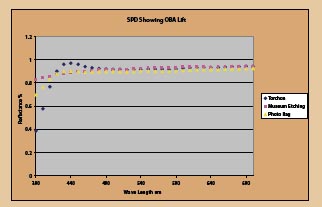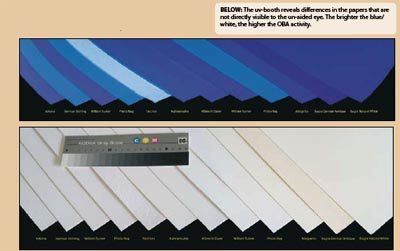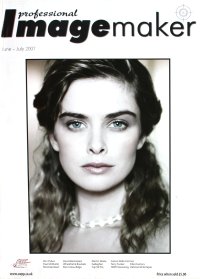articles/Paper/artexpression-page8
Paper Chase - Hahnemuhle - The Art of Expression - part 8 of 1 2 3 4 5 6 7 8 9 10 11 12 13 14
by Mike McNamee Published 01/06/2007

To OB or not to OB? - that is the question
Optical Brightening Agents (OBAs) are added to the base material, the surface coating or both, to make a paper look 'brighter'. This occurs by a process known as fluorescence - light hitting an OBA is reflected back at a higher wavelength. Thus, short wavelength ultraviolet light is invisible to the eye, but is fluoresced out of the OBA as blue light. A paper containing OBAs can thus reflect back more than 100% of the visible light shining upon it (its natural reflectance, plus the fluorescent component). To the observer the paper appears both brighter and cooler. Conversely, OBA-free papers are warmer, creamier and less bright and usually more expensive if quality is to be preserved.

The downside of OBAs is that they cease working after long-term exposure to uv light and allow the creamier base of the paper to show though. The chemicals themselves may also yellow with age. This can be a quandary for the photographer, who may prefer the brightness of the OBA-containing print, but fear for the archival stability of the image. For many in the fine art community (and that includes, particularly, the fine art monochrome enthusiasts) OBAs are a complete 'no-no'. You pay your money and make your choice, OBA-free papers have to be more refined in production and use more expensive rag products, often at 100%. In addition there can be issues when making icc profiles for papers containing OBAs. Unsophisticated spectrophotometers do not screen out the uv components of colour - they can 'see' them, even though the eye cannot. The result is a print that is over compensated towards yellow. This is one reason why scanner-based profiling solutions are not as accurate as spectro-based ones. It is also incidentally why OBA-free papers deliver better colour audit statistics - the gamut is matched to the base paper tone, dragging skin tones too blue in OBA-containing papers, whereas the OBA-free paper leaves them exactly at the right spot. The eye, of course, accommodates for this drift and so the error is not visually obvious even when the statistics detect the effect.
Please Note:
There is more than one page for this Article.
You are currently on page 8
- Paper Chase - Hahnemuhle - The Art of Expression page 1
- Paper Chase - Hahnemuhle - The Art of Expression page 2
- Paper Chase - Hahnemuhle - The Art of Expression page 3
- Paper Chase - Hahnemuhle - The Art of Expression page 4
- Paper Chase - Hahnemuhle - The Art of Expression page 5
- Paper Chase - Hahnemuhle - The Art of Expression page 6
- Paper Chase - Hahnemuhle - The Art of Expression page 7
- Paper Chase - Hahnemuhle - The Art of Expression page 8
- Paper Chase - Hahnemuhle - The Art of Expression page 9
- Paper Chase - Hahnemuhle - The Art of Expression page 10
- Paper Chase - Hahnemuhle - The Art of Expression page 11
- Paper Chase - Hahnemuhle - The Art of Expression page 12
- Paper Chase - Hahnemuhle - The Art of Expression page 13
- Paper Chase - Hahnemuhle - The Art of Expression page 14
1st Published 01/06/2007
last update 09/12/2022 14:51:14
More Paper Articles
There are 0 days to get ready for The Society of Photographers Convention and Trade Show at The Novotel London West, Hammersmith ...
which starts on Wednesday 14th January 2026





